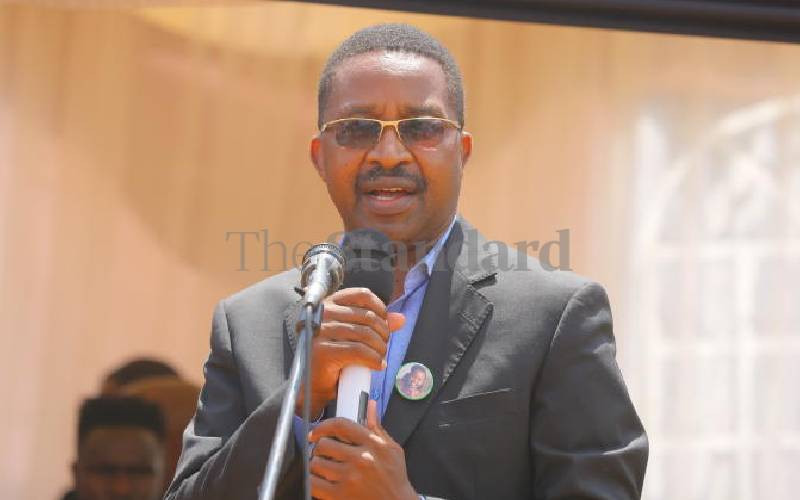NAIROBI: If history is anything to go by, then Cabinet Secretaries named in the EACC report have little to worry about stepping aside to allow investigations into their conduct.
Virtually all the high-profile state officials — Cabinet ministers in particular — who have previously “stepped aside” resumed office upon “being cleared” of any wrong doing.
Senate Minority Leader Moses Wetang’ula was the last official to step aside from the Coalition government Cabinet in October 2010 to pave way for investigations into huge amounts spent in the acquisition of new building to house the Kenyan embassy in Tokyo, Japan.
Wetang’ula, who is highly critical of President Uhuru Kenyatta’s move on graft, was Foreign Affairs minister. Like those before him, he was cleared of any wrong doing and retained in the Cabinet by President Mwai Kibaki, but in the new docket of Trade.
Now Wetan’gula and his colleagues in the Opposition opine the President “is not serious about fighting corruption”.
Before Wetang’ula, an initially defiant Finance minister Amos Kimunya was compelled to step down in November 2008 following the irregular sale of the Grand (now Laico) Regency Hotel in Nairobi.
Prior to the move, Kimunya had vowed at a public rally in his Kipipiri Constituency that, “I would rather die than resign!” An official inquiry cleared Kimunya of any wrongdoing, although the commission’s report was never made public. Kibaki reappointed him as Trade minister.
BACK TO THE FOLD
Fiery politician and a former assistant minister, Koigi wa Wamwere, observes the ministers always find their way back to government courtesy of collusion with the top leadership.
“When the top leadership is under so much pressure, they ordinarily ask their close ministers to briefly step aside and take the flak on their behalf so that when the storm calms down they are returned to office,” says Koigi.
Koigi also remembers the case of former powerful Industrialisation minister, Nicholas Biwott, being relieved of his ministerial duties by President Daniel arap Moi following pressure from the donor community. The “Total Man”, as Biwott was famously known, returned to the Cabinet two years later.
Justice minister Kiraitu Murungi equally left office over the Anglo Leasing scandal in 2006. He bounced back to the Cabinet as Energy minister.
The late Prof George Saitoti also stepped aside as Education minister over the Goldenberg scandal. The scam involved the theft of public funds through a bogus gold and diamond export scheme.
He was reappointed to the same ministry by President Kibaki on November 15, 2006.
As it may be the case now with some, not all ministers adhered to Kibaki’s quit orders. His own Vice President, Moody Awori, refused to resign. “I am not resigning. I honestly and sincerely see no reason to step down. Who is my accuser and what am I being accused of?” thundered the Funyula MP at a Press conference on February 2, 2006.
Stay informed. Subscribe to our newsletter
Nonetheless, Kibaki was decisive on Dr Chris Murungaru, his Internal Security minister.
Unlike the rest, Kibaki did not accord Murungaru a chance to step aside for investigations.
He transferred him to the Ministry of Transport at the heat of the Anglo Leasing scam and dropped altogether in a Cabinet reshuffle in November 2005.
 The Standard Group Plc is a
multi-media organization with investments in media platforms spanning newspaper
print operations, television, radio broadcasting, digital and online services. The
Standard Group is recognized as a leading multi-media house in Kenya with a key
influence in matters of national and international interest.
The Standard Group Plc is a
multi-media organization with investments in media platforms spanning newspaper
print operations, television, radio broadcasting, digital and online services. The
Standard Group is recognized as a leading multi-media house in Kenya with a key
influence in matters of national and international interest.
 The Standard Group Plc is a
multi-media organization with investments in media platforms spanning newspaper
print operations, television, radio broadcasting, digital and online services. The
Standard Group is recognized as a leading multi-media house in Kenya with a key
influence in matters of national and international interest.
The Standard Group Plc is a
multi-media organization with investments in media platforms spanning newspaper
print operations, television, radio broadcasting, digital and online services. The
Standard Group is recognized as a leading multi-media house in Kenya with a key
influence in matters of national and international interest.








